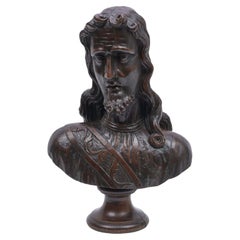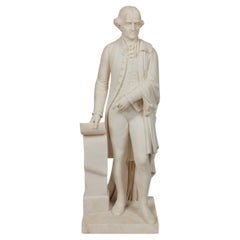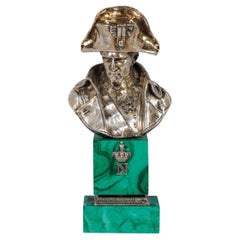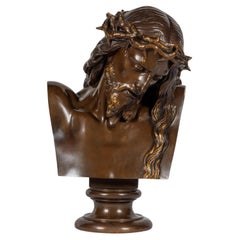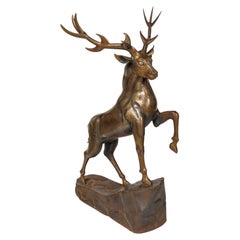Solomon Treasure Sculptures
to
5
35
1
1
18
16
1
2
1
2
1
29
15
12
11
7
36
32
16
11
3
1
Height
to
Width
to
36
36
36
4
3
1
1
1
A Monumental 16th Century Renaissance Carved Oak Bust of Jesus Christ
Located in Queens, NY
Magnificent and Monumental 16th Century Renaissance Carved Oak Bust of Christ, Flemish Netherlandish, C. 1550
A powerful and deeply expressive Renaissance carved oak bust of Jesus C...
Category
Antique 16th Century Dutch Renaissance Busts
Materials
Oak
A Rare and Important American Marble Sculpture of Thomas Jefferson, Circa 1870
Located in Queens, NY
A Rare and Important American White Marble Sculpture of Thomas Jefferson Holding The Declaration of Independence. Circa 1870, in the Manner of Horatio Stone (1808 –1875).
Inscribed on scroll: 'The Declaration of Independence, It becomes necessary for one people to dissolve the political bands which have connected them with another. etc. etc. T. Jefferson.
The present work is unsigned but is reminiscent of Horatio Stone's life-size marble figure of John Hancock...
Category
Antique 19th Century American American Classical Figurative Sculptures
Materials
Marble
An Exquisite French Silver and Malachite Bust of Napoleon, By Emile Pinedo
By Émile Pinedo
Located in Queens, NY
An Exquisite French Silver and Malachite Bust of Napoleon, By Emile Pinedo
This exquisite French silver and malachite bust of Napoleon, masterfully crafted by the esteemed sculptor ...
Category
Antique 19th Century French Napoleon III Busts
Materials
Malachite, Sterling Silver
Adorable Family of Six Buccellati Sterling Silver Furry Chicks on Petrified Wood
By Buccellati
Located in Queens, NY
An Adorable Family of Six Italian Buccellati Sterling Silver Furry Chicks Resting on a Petrified Wood Base, Milan 20th Century
This enchanting creation by the renowned Italian silve...
Category
20th Century Italian Animal Sculptures
Materials
Sterling Silver
A Monumental Patinated Bronze Bust of Jesus Christ by Clesinger and Barbedienne
By Jean-Baptiste Auguste Clesinger, Ferdinand Barbedienne
Located in Queens, NY
A Monumental and Truly Exceptional French Patinated Bronze Bust of Jesus Christ, Circa 1858, Signed J. Clesinger, Rome 1858 & F. Barbedienne Fondeur
This monumental and extraordinar...
Category
Antique 19th Century French Figurative Sculptures
Materials
Bronze
An Exceptional Life-Size Middle Eastern Gold-Inlaid Steel Deer Sculpture
Located in Queens, NY
An Exceptional Life-Size Middle Eastern Gold-Inlaid Steel Deer Sculpture
This extraordinary life-size Middle Eastern deer sculpture exemplifies the pinnacle of artistic craftsmanshi...
Category
20th Century Islamic Animal Sculptures
Materials
Steel
An Elegant Mario Buccellati Sterling Silver Duck Perched on an Amethyst Base
By Mario Buccellati
Located in Queens, NY
An Elegant Mario Buccellati Sterling Silver Duck Perched on an Amethyst Base, Milan, 20th Century
This exquisite creation epitomizes the craftsmanship and luxury for which Mario Buc...
Category
20th Century Italian Animal Sculptures
Materials
Amethyst, Sterling Silver
A Monumental, Richly Patinated Bronze Bust of Beethoven by G. Leroux
By Gaston Leroux
Located in Queens, NY
A Monumental, Richly Patinated Bronze Bust of Beethoven by Gaston Veuvenot Leroux (1854-1942) & Eugène Blot, Fondeur
This magnificent sculpture powerfully captures the iconic compos...
Category
Antique 19th Century French Busts
Materials
Bronze
Le Garde Du Harem, A Monumental Orientalist Bronze Sculpture by G. Coudray
By Georges Charles Coudray
Located in Queens, NY
Le Garde Du Harem, "The Harem Guard" A Monumental Orientalist Patinated Bronze Sculpture by Georges Charles Coudray (French, 1862-1932)
Le Gar...
Category
Antique 19th Century French Figurative Sculptures
Materials
Bronze
A Large Buccellati Silver Model of a Realistic Lobster
By Mario Buccellati
Located in Queens, NY
A Large Buccellati Italian Silver Model of a Realistic Lobster
Expertly crafted to capture the essence of the real lobster, this model features exquisite detailing and lifelike realism.
Every segment of the lobster is intricately designed, showcasing Buccellati’s renowned artistry. The model boasts realistically textured surfaces that reflect the natural beauty of the Caribbean spiny lobster. The antennae are articulated and detachable, adding an extra layer of sophistication and realism to the piece.
Featured in Architectural Digest By Hannah Martin, May 6, 2024:
"The Buccellati Lobster Is the Surreal Icon We Need Right Now
Can any object elevate a tablescape quite like a sterling silver crustacean?"
Marked M. Buccellati and 800 on back of tail.
9” high x 16” wide x 6" wide
Very good condition, ready to place. A fun and unique piece, - very attractive.
*See our other listings for another, larger Buccellati silver...
Category
20th Century Italian Animal Sculptures
Materials
Silver
A Large Buccellati Silver Model of a Realistic Caribbean Spiny Lobster
By Mario Buccellati
Located in Queens, NY
A Large Buccellati Italian Silver Model of a Realistic Caribbean Spiny Lobster
Expertly crafted to capture the essence of the real lobster, this m...
Category
20th Century Italian Animal Sculptures
Materials
Sterling Silver
A Pair of Opulent Sterling Silver-Gilt Camel Incense Burners, circa 1900
Located in Queens, NY
A Pair of Opulent Sterling Silver-Gilt 925 Camel Incense Burners on Giltwood Stands, Circa 1900
Masterfully crafted, these pieces epitomize the grandeur and sophistication of the pe...
Category
Early 20th Century Anglo-Indian Animal Sculptures
Materials
Sterling Silver
$7,200 Sale Price
60% Off
Museum Quality French White Marble Roundel Relief of Emperor Napoleon III, 1860
Located in Queens, NY
A museum quality French white marble roundel relief of Emperor Napoleon III, circa 1860.
The quality of this marble sculpture of Napoleon III is trul...
Category
Antique 19th Century French Napoleon III Figurative Sculptures
Materials
Marble
Isidore-Jules Bonheur, A Rare Gilt and Patinated Bronze Jockey on A Horse
By Isidore Jules Bonheur
Located in Queens, NY
Isidore-Jules Bonheur (French, 1827–1901)
A Rare Gilt and Patinated Bronze Jockey on A Horse, circa 1875.
Introducing a truly exceptional and highly s...
Category
Antique 19th Century French Sporting Art Animal Sculptures
Materials
Bronze
$14,850 Sale Price
44% Off
Pair of French Ormolu and Patinated Bronze Figural Busts on Porphyry Bases
Located in Queens, NY
A Pair of French Ormolu and Patinated Bronze Figural Busts on Porphyry Bases, circa 1875.
One bust signed Marin, the other L.V.E Robert - a truly magnificent pair of busts...
Category
Antique 19th Century French Napoleon III Figurative Sculptures
Materials
Porphyry, Bronze, Ormolu
Exquisite 14K Gold, Diamonds, Emeralds, Rubies, Semi Precious Stone Camel
Located in Queens, NY
An Exquisite 14K Gold, Diamonds, Emeralds, Rubies, Sapphires, and Semi Precious Stone Mounted Rhodonite Camel.
Possibly by Verdura, circa 1970, Italy.
A very good quality and unusual gold mounted jeweled object...
Category
20th Century Italian Mounted Objects
Materials
Gold
Chaumet Paris, a French Silver-Gilt Seahorse Mounted Rhodochrosite Cup
By Chaumet
Located in Queens, NY
Chaumet Paris, A French Silver-Gilt Seahorse Mounted Rhodochrosite cup
Circa 1980.
An exceptional object
A quadrangular cut cup in rhodochrosite and the handle made of a sea...
Category
Late 20th Century French Brutalist Mounted Objects
Materials
Sterling Silver
$14,000 Sale Price
60% Off
Mario Buccellati, a Rare and Exceptional Italian Silver Goat
By Mario Buccellati
Located in Queens, NY
Mario Buccellati, a rare and exceptional Italian silver goat
circa 1940.
Made in Milan Italy.
Very fine quality and workmanship and very large in size.
Measures: 12" high x 14" w...
Category
20th Century Italian Animal Sculptures
Materials
Silver
Monumental French Patinated Bronze Bust of William Shakespeare, After Houdon
By F. Barbedienne Foundry
Located in Queens, NY
A monumental French patinated bronze bust of William Shakespeare, after Houdon, by F. Barbedienne Foundry, circa 1870.
Masterfully and realistically sculpted in solid bronze, this...
Category
Antique 19th Century French Napoleon III Busts
Materials
Bronze
Rare Carved Hawk's Eye Agate Tiger on a 14K Gold Mounted Rock Crystal Base
By Cartier
Located in Queens, NY
A rare carved Hawk's Eye agate tiger on a 14k gold mounted rock crystal base, circa 1960.
"A Jeweled Sculpture"
An incredible carved tiger made...
Category
20th Century German Animal Sculptures
Materials
Agate, Rock Crystal, Gold
Margaret Foley (American, 1827-1877) Marble Bust "Head of Prophet Zephaniah"
Located in Queens, NY
Margaret Foley (American, 1827-1877) Marble Bust "Head of Prophet Zephaniah"
A rare and important marble bust head relief portrait on The Prophet Zepha...
Category
Antique 19th Century Italian American Empire Busts
Materials
Marble
Important Ormolu and Silvered Bronze Figural Wine Cooler, Possibly Russian, 1860
By Pavel Sazikov
Located in Queens, NY
Important ormolu and silvered bronze figural wine cooler, possibly Russian, 1860
Gilt and silvered bronze wine cooler. Modeled with two Russian polar bears at the handles and with a young gunmen holding a rifle seated with a sea otter...
Category
Antique 19th Century Russian Wine Coolers
Materials
Bronze
Mellerio Paris, a Silver, Gold, Lapis Lazuli, Coral, and Hardstone Picture Frame
By Mellerio
Located in Queens, NY
Mellerio Paris, a large silver, gold, lapis lazuli, coral, and hardstone picture photo frame with two falcons.
France, circa 2000
The frame resting on a lapis lazuli base with squa...
Category
21st Century and Contemporary French Picture Frames
Materials
Coral, Lapis Lazuli, Silver
Monumental Silvered and Gilt-Bronze Glass Centerpiece of "Poseidon"
Located in Queens, NY
A Monumental French Silvered and Gilt-Bronze and Glass Centerpiece of "Poseidon", Paris, circa 1895.
A very good quality centerpiece depicting "Poseidon and his seahorses", of mon...
Category
Early 20th Century French Classical Greek Centerpieces
Materials
Bronze
$37,500 Sale Price
50% Off
Gianmaria Buccellati, a Rare and Exceptional Italian Silver Bobcat
By Gianmaria Buccellati
Located in Queens, NY
Gianmaria Buccellati, a rare and exceptional Italian silver bobcat,
circa 1990s.
Made in Milan, Italy.
Retail price was $72,000 USD + Tax.
Very fine quality and workmanship...
Category
20th Century Italian Sterling Silver
Materials
Silver
$35,000 Sale Price
30% Off
Rare and Important Italian White Marble Bust Sculpture of Jesus Christ, C. 1850
Located in Queens, NY
Rare and important Italian white marble bust sculpture of Jesus Christ, C. 1850.
A truly exceptionally carved marble relief of Holy Jesus Christ. ...
Category
Antique 19th Century Italian Renaissance Busts
Materials
Marble
Exceptional White Marble Figural Sculpture Clock, "Nubian Slaying the Lion"
Located in Queens, NY
An exceptional and monumental white marble figural sculpture clock, "A Nubian Slaying The Lion" by Jean-Joseph Jacquet (Belgian, 1822–1898), c...
Category
Antique 19th Century Belgian Figurative Sculptures
Materials
Marble
An Exquisite and Rare French Louis XVI Style Ormolu-Mounted Bloodstone Inkwell
Located in Queens, NY
An Exquisite and Rare French Louis XVI Style Ormolu-Mounted Bloodstone Inkwell, circa 1875.
A truly exceptional and jewel like quality inkwell encrier, made with the finest ormolu, mounted on bloodstone. A true collectors and one of a kind piece.
Revival of the ancient régime in the late 19th century was paramount to the French furniture and bronze casting firms of the Belle Epoque. Imitation in the highest regard and replication of those tastes and styles was prevalent throughout the Paris Faubourg, where the most talented bronziers and ébénistes established their workshops. The present inkwell encrier recalls the late 18th century's obsession with hardstones - a taste expounded above all by the duc d'Aumont and, subsequently Marie-Antoinette. Such hardstone-mounted pieces, reminiscent of Renaissance schatzkammer objects, enjoyed a revived popularity at the end of the 18th century through the impetus of both the marchands-mercier and, more importantly, the hôtel des Menus-Plaisirs, where the duc d'Aumont himself established a workshop in 1770 specializing in the cutting and polishing of precious hardstones.
This exceptional inkwell encrier, sumptuously-mounted with finely chased gilt-bronzes, incorporates a highly-prized material such as bloodstone.
Sometimes called the Sunstone, the meaning of Bloodstone comes entangled in fascinating history. The Ancient Greeks held the Bloodstone as a gem with glorious powers. They referred to it as Heliotrope, which directly translates to Sunstone. It was believed to have heavenly healing powers gifted by the gods and most certainly when it came to healing all things related to the blood. Even as we move forward into the Middle Ages, the Bloodstone takes another mystical story under its wing. It was believed to be formed from Christ's blood. It was said that during the Crucifixion, a few red spots of his blood dripped...
Category
Antique 19th Century French Napoleon III Inkwells
Materials
Bronze, Ormolu
Mellerio Paris, A French Gold, Diamonds, Silver, and Smoky Quartz Carved Horse
By Mellerio
Located in Queens, NY
Mellerio Paris, A French Gold, Diamonds, Silver-Gilt, Rock-Crystal, Jade, Mother-Of-Pearl and Smoky Quartz, Carved Horse Sculpture, Jeweled Mounted Object.
An extremely rare and unique, one of a kind French gold, diamonds, Silver-gilt, rock-crystal, jade, obsidian, mother-of-pearl, and smoky quartz carved jeweled sculpture "CHEVAUX DE LEGENDE", "A Legendary Horse" by Mellerio, Paris, circa 1991.
Sitting on black obsidian base, the solid rock-crystal slab is finely applied with a carved smoky -quartz and jade horse with a harness mounted in 18k gold, brilliant -cut diamonds, rubies, turquoise, and amethyst chains and pendants. The top columns adorned with 18k gold and brilliant cut diamond pendants, the bottom with gold and mother of pearl plaques. The obsidian base with a plaque engraved: CHEVAUX DE LEGENDE" / N° 05 / MELLERIO DITS MELLER / PARIS / 5003 D
The piece is in excellent condition and comes with a custom made wood case made for transport. It's very elegant and has French hallmarks throughout. A truly magnificent piece.
Measures 10.5" high x 8.5" wide x 4" deep
Founded in France in 1613 by the descendants of Italian immigrants from the Vigezzo Valley in the north of Italy, Mellerio is one of the oldest jewellery houses in Europe. The family business soon attracted the attention of the Royal Court and Marie Antoinette herself reportedly purchased a precious bracelet featuring 7 cameos surrounded by rubies in 1780. Later on, in the 19th century, Mellerio became the official supplier of the French Royal family and the Court of Netherland.
Mellerio creates many jewellery items, all set with rare gems such as peridots, amethysts, aquamarines, citrines and topaz, applying for a patent, the flexible stem, a very supple and light jewellery mechanism. Mellerio remains also well known for their spectacular series of Art Nouveau jewels, created at the beginning of the 20th century, as well as for the creation of trophies rewarding some of the greatest footfall and tennis players of history. In 1993, the jewellery house launched their first watch collection.
Today, Mellerio has stores in Paris, Japan and Hong Kong.
July 14, 1789: this date is known throughout the world as the beginning of the French Revolution. According to a ledger belonging to House of Mellerio, this was also the day that the jeweler sold a golden key to the Comte de Coutance for 10 livres. This ledger, as well as inventories dating as far back as 1768, are the jeweler’s oldest archives. These archives have continued to grow over the years, as the House, established on rue de la Paix in Paris, still lives on today, still in the hands of the same family from Craveggia, in the North of Italy.
The tumultuous history of the Mellerio family in France probably goes as far back as the Italian wars of the Renaissance, but the first official document proving their commercial activity in Paris dates back to 1613. This document is the famous royal warrant awarded by Marie de Medici to a number of Italian families established along the rue des Lombards, including the Mellerios, allowing them to sell “small jewelery items”, therefore granting them a small exception to the traditional monopoly enjoyed by Parisian jewelers. At that time, powerful corporations regulated the operations and customs of Parisian business, but thanks to this exceptional warrant, the Mellerios managed to escape the confines of this framework. Today, this wax-sealed document is kept at the city hall of Craveggia.
From 1613 to the Revolution, the Mellerios lived between France and Italy. The corporations tried many times to put an end to their trade privileges, but all in vain, as a dynasty of sovereigns renewed the warrant. Always marrying and often retiring in Craveggia, the Mellerios continued to maintain their jewelry business in Paris. At first, they did this without a shop. Wearing backpacks (wooden boxes divided into small compartments where jewels were kept), they would tour town fairs around Paris and royal castles.
This is how Jean-Baptiste Mellerio (1765-1850) is said to have sold a bracelet set with rubies and Antique cameos to Marie-Antoinette, which still exists today. Many elements seem to prove the veracity of this anecdote. The queen was particularly fond of cameos, which cover the entire background of her famous jewelry cabinet, and ruby was her favorite stone after diamond. The famous bracelet, reacquired a few years ago by the House of Mellerio, is indeed an 18th century jewel, set with antique cameos representing the profiles of Roman emperors. Two branches of the family were operating in Paris during this time, under the reign of Louis XVI: that of Jean-François (1746-1828), the paternal ancestor of the current Mellerios, and that of Jean-Baptiste (1765-1850).
The French Revolution forced them to return to Italy. However, both Jean-Baptiste and François Mellerio (1772-1843), who was the son of Jean-François, were eventually able to return to Paris after the founding of the Consulate. Jean-Baptiste opened a shop at the Iron Crown of rue Vivienne, and François opened his at the Palais des Tuileries, rue du Coq Saint-Honoré. His well-organized order books give an idea of his high-ranking clientele during the “Old Regime”, among which were the Comte and Comtesse Octave de Segur, the Marquise (later Duchess) de Tourzel, former governess of the royal children, and her daughter, the Comtesse de Bearn, the Craufurds -who organized the flight to Varennes, the Duc and Duchess de Gramont, the Comtesse de Boigne, and Madame de Souza, Talleyrand’s mistress.
We also see the names of the imperial family: Empress Josephine, the Queen of Holland, Princess Elisa, Caroline and Pauline. At that time, the House of Mellerio specialized, among other things, in the trade of antique cameos, a newly fashionable genre of jewel that captured the imagination of all the princesses and noble women of the time.
The years of the Restauration and July Monarchy were among the most glorious. The Bourbons were back on the throne, and the clientele of the House of Mellerio had regained its former wealth. Mellerio supplied Louis-Philippe, Duke of Orléans, as well as his mother, wife and sister, with sumptuous jewels, including a set of emeralds made piece by piece, while the Duke of Bourbon, last prince of the House of Condé, offered diamonds to his mistress, the scheming Baronne de Feucheres, and Monsieur de LaFayette also bought cameos for one of his granddaughters. For the first time, Mellerio ventured into the world of arts in 1815, when Carlotta Grisi, a famous dancer who created Giselle, as well as an actress named Rachel, bought jewels at the Mellerio store on rue de la Paix.
1848 marked a new turning point. France once again became a Republic. François Mellerio handed the company over to his son, Jean, and the latter decided to travel to Spain to build a new clientele. He later became one of the jewelers of the royal family, and met Eugénie de Montijo, who remained a faithful client when she became empress of the French people. The Imperial years were lavish. During the Second Empire, Paris was a pageant of crinoline dresses designed by Worth, while jewels by Mellerio, Worth’s neighbour on the rue de la Paix, adorned the noble women of the Tuileries court.
The Empress bought pearls. Mathilde Bonaparte...
Category
20th Century French Mounted Objects
Materials
Rock Crystal, Jade, Quartz, Gold, Silver
Rare Patinated Bronze Sculpture of Benjamin Franklin, by A. Carrier-Belleuse
By Albert-Ernest Carrier-Belleuse
Located in Queens, NY
Albert-Ernest Carrier-Belleuse (France, 1824-1887)
A rare seated bronze statue of Benjamin Franklin holding his walking stick and hat, with a book in his ri...
Category
Antique 19th Century French American Classical Figurative Sculptures
Materials
Bronze
Rare 18K Gold, Enamel and Diamond Mounted Carved Labradorite Turkey Bird
By Manfred Wild
Located in Queens, NY
A rare 18K gold, enamel and diamond mounted carved labradorite turkey / Capercaillie bird sculpture on a petrified wood base, attributed to Manfred Wild, Idar-Oberstein, Germany.
Very finely crafted of the highest quality and best color Madagascar labradorite with excellent labradorescence. The entire hand carved turkey displays and excellent shimmer effect known as labradorescence.
Madagascar labradorite, rich in the phenomenal characteristics of this remarkable gemstone which displays an ever-changing sheen, that is extremely suitable for the rendering of this turkey bird...
Category
20th Century German Mounted Objects
Materials
Gold, Enamel
Mellerio Paris, A French Gold, Diamond, Silver-Gilt, Rock-Crystal, & Lapis Horse
By Mellerio
Located in Queens, NY
Mellerio Paris, A French Gold, Diamond, Silver-Gilt, Rock-Crystal, Obsidian & Lapis Horse
An extremely rare and unique, one of a kind French gold, diamonds, Silver-gilt rock-crystal, obsidian and lapis lazuli jeweled sculpture "Bucéphale, Chevaux de légende", "Bucephalus, A Legendary Horse" by Mellerio, Paris, circa 1998.
Sitting on black obsidian base, the solid rock crystal slab is finely applied with a lapis lazuli half-horse with harness mounted in 18k gold and brilliant cut diamonds, between two crystal and lapis lazuli columns adorned with gold and diamonds, insert with 7 ruby cabochons and 1 emerald cabochon, the obsidian base with a plaque engraved: CHEVAUX DE LEGENDE / MELLERIO DITS MELLER / PARIS / 5029 DIV
Bucephalus (c355-326 BC) is among the most famous horses in history, and it was said that this he could not be tamed. The young Alexander the Great, of course, tamed him – and went on to ride his beloved equine companion for many years and into many battles.
The piece is in excellent condition and comes with a custom made wood case made for transport. It's very elegant and has French hallmarks throughout. A truly magnificent piece.
Measures 10" high x 9" wide x 4" deep
Founded in France in 1613 by the descendants of Italian immigrants from the Vigezzo Valley in the north of Italy, Mellerio is one of the oldest jewellery houses in Europe. The family business soon attracted the attention of the Royal Court and Marie Antoinette herself reportedly purchased a precious bracelet featuring 7 cameos surrounded by rubies in 1780. Later on, in the 19th century, Mellerio became the official supplier of the French Royal family and the Court of Netherland.
Mellerio creates many jewellery items, all set with rare gems such as peridots, amethysts, aquamarines, citrines and topaz, applying for a patent, the flexible stem, a very supple and light jewellery mechanism. Mellerio remains also well known for their spectacular series of Art Nouveau jewels, created at the beginning of the 20th century, as well as for the creation of trophies rewarding some of the greatest footfall and tennis players of history. In 1993, the jewellery house launched their first watch collection.
Today, Mellerio has stores in Paris, Japan and Hong Kong.
July 14, 1789: this date is known throughout the world as the beginning of the French Revolution. According to a ledger belonging to House of Mellerio, this was also the day that the jeweler sold a golden key to the Comte de Coutance for 10 livres. This ledger, as well as inventories dating as far back as 1768, are the jeweler’s oldest archives. These archives have continued to grow over the years, as the House, established on rue de la Paix in Paris, still lives on today, still in the hands of the same family from Craveggia, in the North of Italy.
The tumultuous history of the Mellerio family in France probably goes as far back as the Italian wars of the Renaissance, but the first official document proving their commercial activity in Paris dates back to 1613. This document is the famous royal warrant awarded by Marie de Medici to a number of Italian families established along the rue des Lombards, including the Mellerios, allowing them to sell “small jewelery items”, therefore granting them a small exception to the traditional monopoly enjoyed by Parisian jewelers. At that time, powerful corporations regulated the operations and customs of Parisian business, but thanks to this exceptional warrant, the Mellerios managed to escape the confines of this framework. Today, this wax-sealed document is kept at the city hall of Craveggia.
From 1613 to the Revolution, the Mellerios lived between France and Italy. The corporations tried many times to put an end to their trade privileges, but all in vain, as a dynasty of sovereigns renewed the warrant. Always marrying and often retiring in Craveggia, the Mellerios continued to maintain their jewelry business in Paris. At first, they did this without a shop. Wearing backpacks (wooden boxes divided into small compartments where jewels were kept), they would tour town fairs around Paris and royal castles.
This is how Jean-Baptiste Mellerio (1765-1850) is said to have sold a bracelet set with rubies and Antique cameos to Marie-Antoinette, which still exists today. Many elements seem to prove the veracity of this anecdote. The queen was particularly fond of cameos, which cover the entire background of her famous jewelry cabinet, and ruby was her favorite stone after diamond. The famous bracelet, reacquired a few years ago by the House of Mellerio, is indeed an 18th century jewel, set with antique cameos representing the profiles of Roman emperors. Two branches of the family were operating in Paris during this time, under the reign of Louis XVI: that of Jean-François (1746-1828), the paternal ancestor of the current Mellerios, and that of Jean-Baptiste (1765-1850).
The French Revolution forced them to return to Italy. However, both Jean-Baptiste and François Mellerio (1772-1843), who was the son of Jean-François, were eventually able to return to Paris after the founding of the Consulate. Jean-Baptiste opened a shop at the Iron Crown of rue Vivienne, and François opened his at the Palais des Tuileries, rue du Coq Saint-Honoré. His well-organized order books give an idea of his high-ranking clientele during the “Old Regime”, among which were the Comte and Comtesse Octave de Segur, the Marquise (later Duchess) de Tourzel, former governess of the royal children, and her daughter, the Comtesse de Bearn, the Craufurds -who organized the flight to Varennes, the Duc and Duchess de Gramont, the Comtesse de Boigne, and Madame de Souza, Talleyrand’s mistress.
We also see the names of the imperial family: Empress Josephine, the Queen of Holland, Princess Elisa, Caroline and Pauline. At that time, the House of Mellerio specialized, among other things, in the trade of antique cameos, a newly fashionable genre of jewel that captured the imagination of all the princesses and noble women of the time.
The years of the Restauration and July Monarchy were among the most glorious. The Bourbons were back on the throne, and the clientele of the House of Mellerio had regained its former wealth. Mellerio supplied Louis-Philippe, Duke of Orléans, as well as his mother, wife and sister, with sumptuous jewels, including a set of emeralds made piece by piece, while the Duke of Bourbon, last prince of the House of Condé, offered diamonds to his mistress, the scheming Baronne de Feucheres, and Monsieur de LaFayette also bought cameos for one of his granddaughters. For the first time, Mellerio ventured into the world of arts in 1815, when Carlotta Grisi, a famous dancer who created Giselle, as well as an actress named Rachel, bought jewels at the Mellerio store on rue de la Paix.
1848 marked a new turning point. France once again became a Republic. François Mellerio handed the company over to his son, Jean, and the latter decided to travel to Spain to build a new clientele. He later became one of the jewelers of the royal family, and met Eugénie de Montijo, who remained a faithful client when she became empress of the French people. The Imperial years were lavish. During the Second Empire, Paris was a pageant of crinoline dresses designed by Worth, while jewels by Mellerio, Worth’s neighbour on the rue de la Paix, adorned the noble women of the Tuileries court.
The Empress bought pearls. Mathilde Bonaparte...
Category
20th Century French Mounted Objects
Materials
Lapis Lazuli, Rock Crystal, Gold, Silver
18K Gold, Diamonds, Amethyst, Tourmaline, Bloodstone, and Jasper Toucan Bird
Located in Queens, NY
An 18K gold, diamonds, amethyst, tourmaline, bloodstone, carved emerald, opal and jasper toucan bird resting on a gold tree branch, mounted on a carved malachite base.
A very rare and unique gold-mounted jeweled object...
Category
20th Century Italian Mounted Objects
Materials
Amethyst, Malachite, Opal, Tourmaline, Gold
Palatial & Rare Napoleon III French Ormolu and Patinated Bronze Clock, Detouche
By C. Detouche
Located in Queens, NY
A Palatial and Extremely Rare Napoleon III French Ormolu and Patinated Bronze Regulateur de Parquet Clock by Louis-Constantin Detouche, Paris, Circa 1850
An exceptional testament to the grandeur and technical mastery of 19th-century French horology, this palatial and extraordinarily rare Napoleon III ormolu and patinated bronze Regulateur de Parquet clock stands as a crowning achievement of the renowned Parisian horologist Louis-Constantin Detouche. Created circa 1850, this monumental timepiece exemplifies the perfect synthesis of artistic opulence and mechanical precision, distinguishing itself as one of the most impressive works from Detouche’s illustrious oeuvre.
At over six feet tall, this clock’s imposing scale and decorative grandeur make it an object of immense historical and aesthetic significance. The case, crafted from the finest French ormolu, features two majestic patinated bronze seated putti, serving as allegorical figures and underscoring the artistic sophistication characteristic of the Second Empire style. The white enamel dial, elegantly signed "C. Detouche/Paris," affirms its prestigious maker, while the movement, meticulously numbered 7064 and bearing the stamps "C. Detouche RUE St. MARTIN" and "C. DETOUCHE 158 R. St MARTIN 160," speaks to the highest standards of 19th-century horological craftsmanship. Further distinguishing this piece is the medaille d’argent stamp, a testament to the numerous accolades and awards bestowed upon Detouche for his innovations in timekeeping.
A Masterpiece of Horological Artistry:
Louis-Constantin Detouche was not merely a clockmaker; he was a visionary whose contributions to horology redefined precision and complexity. This particular regulator clock...
Category
Antique 19th Century French Napoleon III Grandfather Clocks and Longcase...
Materials
Bronze, Ormolu
Enamel Gold and Rock Crystal Figure of Emperor Maximilian I by Reinhold Vasters
Located in Queens, NY
A rare enamel, gold and rock crystal figure of Emperor Maximilian I by Reinhold Vasters, Aachen,
In the Renaissance style, circa 1870.
The g...
Category
Antique Late 19th Century German Renaissance Figurative Sculptures
Materials
Rock Crystal, Gold, Enamel
Rare and Important Italian Alabaster Bust Sculpture of Jesus Christ, C. 1860
Located in Queens, NY
A rare and important Italian alabaster bust sculpture of Jesus Christ, C. 1860
A modeled bust of Holy Christ wearing a crown of thorns, excep...
Category
Antique 19th Century Italian Baroque Busts
Materials
Alabaster
